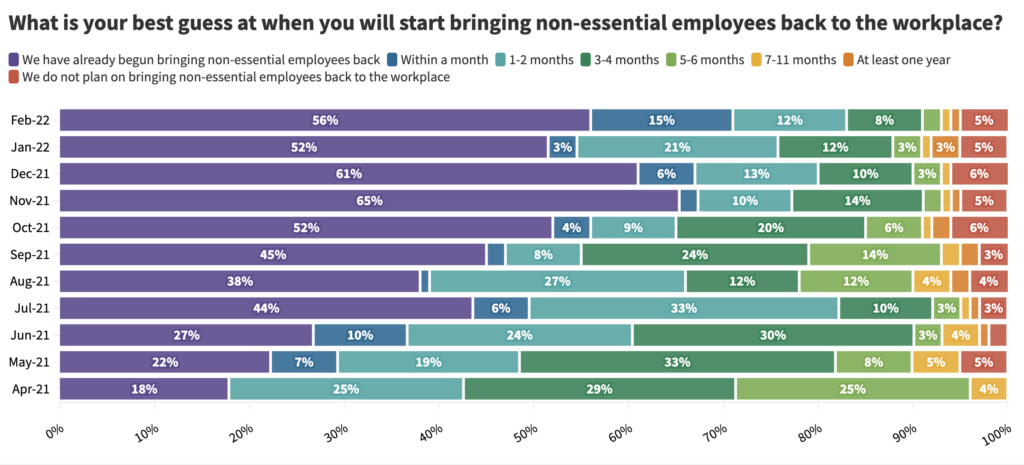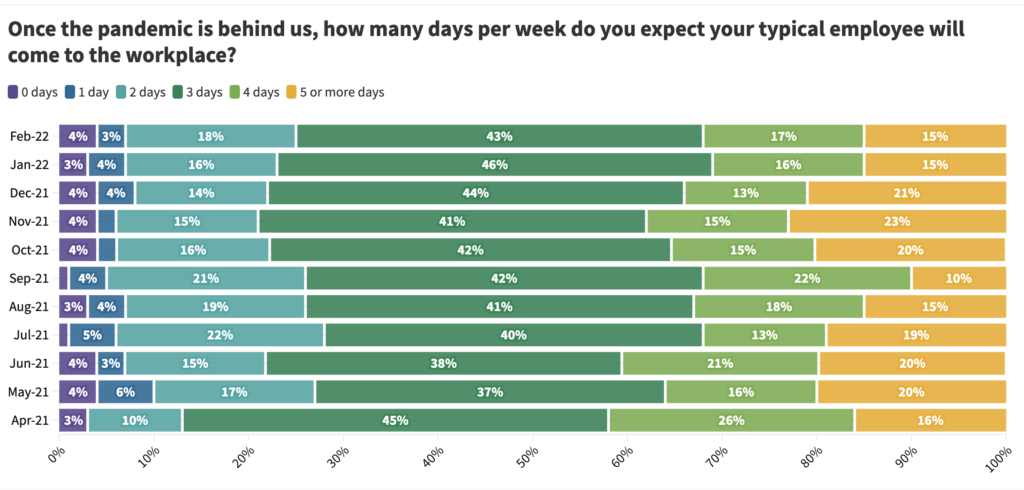Employer Survey: Almost 70% See “New Normal” Operations by Summer
Almost one full year of survey data provided by Bay Area employers shows the post-pandemic “new normal” for in-person office work and public transit commuting is beginning to take shape as non-essential employees slowly start returning to the office. Over 70% of surveyed employers report bringing their workers back to the office by mid-March, and almost the same percentage expect their typical employees will work three days a week or less in the office. Consistently throughout the survey period, most employers anticipated those days are most likely to be Tuesday, Wednesday and Thursday, with a solid majority reporting their new long-term “normal” operations will be fully implemented by June or July. Finally, employers’ concerns about their employees taking public transit to work has begun to drop—an encouraging sign for transit agencies struggling to recover from tumbling ridership levels during the pandemic.
The Bay Area Council has collected monthly survey data from roughly 200 employers throughout the region in partnership with the Metropolitan Transportation Commission and EMC Research since April 2021 in order to gather reopening plans and inform transit agencies and policymakers. After a brief dip in employer confidence levels in solidifying their reopening plans during the Omicron surge, the February survey results, gathered between February 8 – 14, showed the highest number yet (71%) of employers reporting they have either already begun bringing non-essential workers back to the office or plan to do so by mid-March. And this is only the beginning of a gradual return to in-person work: while 35% of employers say they are already operating under their “new normal” long-term reopening plan or expect to by mid-March, 67% say they anticipate operating under their “new normal” by June. A full 82% anticipate a similar return by August or September.
“It’s great to see more employers planning to return to offices and other in-person workplaces,” said Gwen Litvak, Bay Area Council Senior Vice President, Public Policy. “Out downtowns are a source of great urban, social, cultural and economic vitality and are key to making our region thrive. We know we won’t return to a five-day in-person work week, but we are eager to start planning our cities and workplaces for a hybrid environment that is good for workers and good for economic development.”
What will this “new normal” look like?
Since the Council began administering the survey in April 2021, an average of 42% of employers have reported expecting their employees to work in the office three days per week (compared to 70% – 75% who reported a full five-day in-person work week pre-pandemic). Across all respondents, 68% expect their non-essential employees to commute to the office any combination of one to three days per week. The percentage of employers expecting to bring their employees back five days per week is 15%, a number that has fallen during other Covid variant surges but has remained consistent post-Omicron. The percentage of employers who feel somewhat to very confident in their “new normal” number of in-office workdays has ticked up since Omicron, from 86% to 92%. Additionally, employers reported that a shrinking percentage of their workforce will work remotely full-time after Covid restrictions are lifted, from 25% in October 2021 to 20% in February 2022.

The Tuesday-Wednesday-Thursday model of post-pandemic in-office workdays has further stabilized since October 2021, with employers reporting consistently between 62% – 63% of their workforce will return to the office those days. The percentage of workers expected to work in-office on Mondays has dipped below 50%, while Fridays have remained the least popular in-office workdays (40%). More than half of employers have consistently reported anticipating their employees will work more flexible hours in the office since October 2021 vs. an average of 42% anticipating their employees will work traditional 9 to 5 schedules in the office post-pandemic.

See the February survey results>>
Will commuters return to public transit?
It remains to be seen how these returning workers will choose to commute. Data analyzed by the Bay Area Council Economic Institute show people have overwhelmingly been getting around the Bay Area in their cars instead of taking public transit. The region’s seven state-owned toll bridges show overall commute volumes reached 80% of pre-pandemic levels in February, while BART ridership has stagnated near 25% of pre-pandemic numbers. As the threat of the Omicron variant recedes, however, the highest number yet (34%) of surveyed employers in February reported they are ”not very concerned” about the threat of Covid on public transit for their employees. More, the number of employers asking employees not to take public transit dropped back to pre-Omicron levels in February (3%) and those actively encouraging employees to take transit and providing transit benefits has rebounded to 25%.
“To ease commute congestion, it is crucial that commuters, policymakers and transit agencies are aware of the days of the week that employers anticipate peak levels of employees coming to the workplace,” said Kelly Obranowicz, Policy and Regulatory Counsel, Bay Area Council. “As the Bay Area inches toward the ‘new normal,’ the Council and regional transit agencies are working together to do everything possible to reduce the number of single-occupancy vehicles while encouraging commuters to get back on public transit to return to their offices. The economic health of our downtowns, not to mention the region as a whole, will depend on it.”





